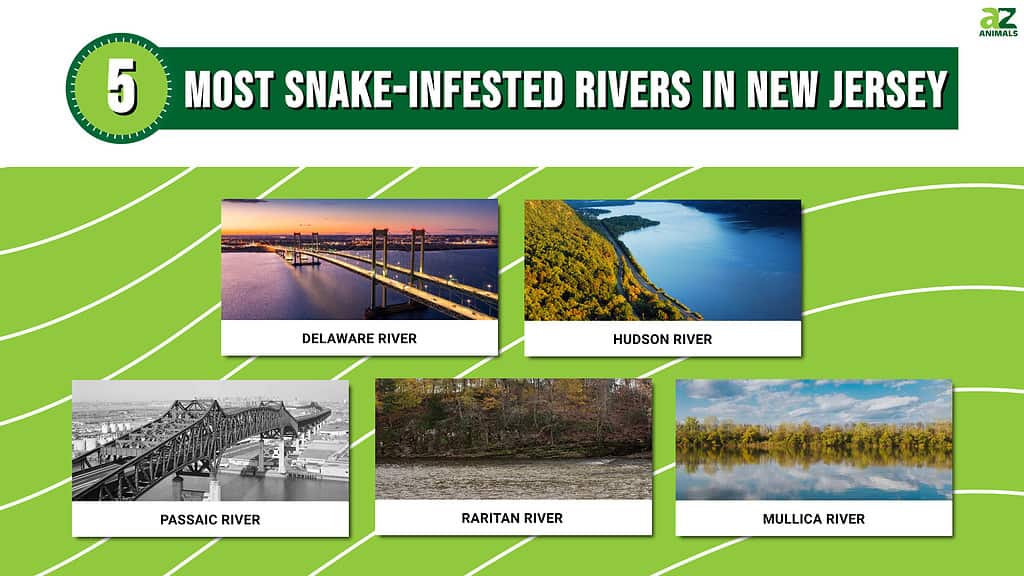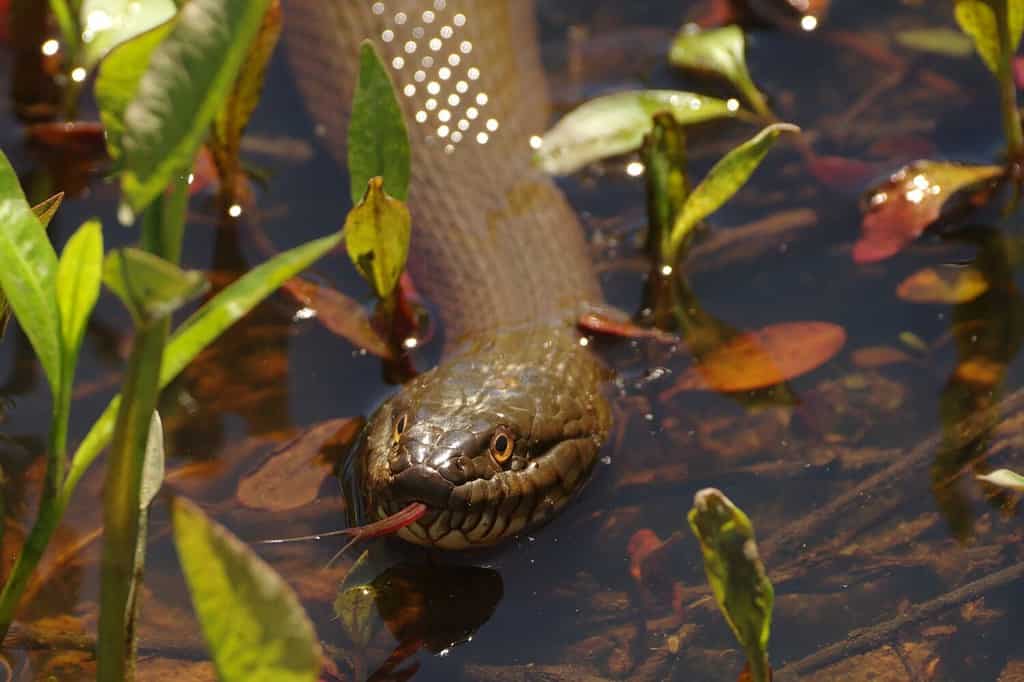There are many species of snake in New Jersey, so it isn’t surprising that you’d find some of them in their rivers. Of course, some rivers in New Jersey are more snake-infested than others. This difference can depend on many factors, such as the amount of human activity and food availability.

Some snake species in New Jersey are venomous. However, snakes play an important role in the ecosystem. For instance, snakes help control the rodent population (and fish population in lakes).
If you encounter a snake, it’s generally best to observe from a safe distance and not disturb the animal. In this article, we’ll discuss what lakes have high populations of snakes in New Jersey, as well as what kinds of snakes you may find.
Water Snakes Found in New Jersey
There are several water snakes found in New Jersey. Some of these are more dangerous than others. While correct identification is important, it’s best to give all snakes plenty of room.
1. Nothern Water Snake

This species is completely harmless to people and one of the most common in New Jersey’s lakes.
©Philip Yabut/Shutterstock.com
The Northern Water Snake (Nerodia sipedon) is a commonly encountered species of non-venomous snake found in various aquatic habitats throughout North America, including New Jersey.
They range from 24 to 42 inches in length, though some individuals grow even larger. They can exhibit a wide range of colors, making it hard to identify them.
Their dorsal (upper) side can vary from brown, gray, or olive to reddish-brown, with darker blotches and bands. The snake’s ventral (lower) side is usually light-colored, often with reddish or pinkish hues.
Their pattern can be extremely variable, but they usually have darker bands.
This water snake is extremely adaptable and can be found in many aquatic environments, such as lakes and rivers. They spend only part of their time in the water, but they are excellent swimmers.
Mostly, they consume amphibians, fish, and small aquatic mammals. They’re skilled hunters and tend to ambush their prey. Northern Water Snakes are non-venomous, but they can be quite feisty when threatened. They might flatten their bodies, release musk, and even strike if they feel cornered.
2. Queen Snake

The queen snake is a nonaggressive, nonvenomous snake found in North America.
©Jason Patrick Ross/Shutterstock.com
You may also find the Queen Snake (Regina septemvittata) in New Jersey. This snake is relatively small, only reaching 24 inches max (though many are much smaller). They have a distinct appearance, making them easier to identify than the Northern Water Snake.
They are light brown to olive brown with a row of darkly colored spots down their back. Their underside is always pale yellow to cream.
Queen Snakes are agile and excellent swimmers, often seen actively foraging in aquatic habitats. They’re semi-aquatic and prefer flowing water, like streams, rivers, and small ponds. They’re known for basking on rocks or vegetation near the water, though they may also seek refuge in crevices and under rocks.
The primary diet of Queen Snakes consists of aquatic insects, such as mayflies, caddisflies, and damselflies. They are specialized feeders, consuming these insects both as adults and larvae.
They are not dangerous to humans and are actually very docile (though we still wouldn’t recommend handling them). This snake helps control the insect population near bodies of water.
5 Most Snake-Infested Rivers in New Jersey
1. Delaware River

This river is very developed along some parts, which discourages snake activity in these areas.
©Mihai_Andritoiu/Shutterstock.com
The Delaware River is a major river on the Atlantic coast of the United States. It drains an area of 13,539 square miles in four U.S. states: Delaware, New Jersey, New York and Pennsylvania. As you might imagine, it is a very important river. It is also one of the most snake-infested rivers in New Jersey.
It was the site of several important events during the American Revolution, including the crossing of George Washington and his troops on December 25, 1776. The river also served as a major trade route through early national times, connecting Philadephia to cities along the coast.
The Delaware River is also home to many different wildlife species, such as fish, burds, reptiles, and amphibians. Some notable animals that live near the river include the timber rattlesnake, snapping turtle, bald eagle, and beaver. The river provides drinking water for more than 15 million people, as well.
Of course, the river also offers many opportunities for recreation. For instance, it’s a popular spot for fishing, boating, and hiking. There are several parks and preserves in and around the river.
2. Hudson River

Like Hudson Bay, the Hudson River is named after Henry Hudson.
©Kirkikis/iStock via Getty Images
The Hudson River is another larger river that is about 315 miles long. It flowers primarily through eastern New York, but it also runs along the border of New Jersey. The river was named about Henry Hudson, who explored the river for the Dutch East India Company in 1609. This same man also had Hudson Bay in Canada named after him.
The river is an important ecological and recreational resource today. It is home to many wildlife species and has many of the same animals living round it as the Delaware River. Snakes do live in the river, of course. Luckily, most are harmless to humans. However, the timber rattlesnake is occassionally found in the river and is venomous.
Many people flock to this river for the recreational activities. It’s a popular place for bird watching. Plus, the river also provides many people with drinking water.
3. Passaic River

This river may be small, but it has played a key part in
industry for hundreds of years.
©Jack Boucher, Public domain, via Wikimedia Commons – License
The Passaic River is located in Northern New Jersey and runs for about 80 miles. it mostly flows through rural and suburban areas, but it does run through soem urban spots down river. The lower river is considered one of the most polluted stretchs of water in the nation, as it has had toxic waste dumped into it in the past. The mud at the bottom of the river is considered toxic downstream.
The river’s snake population isn’t well documented. However, there are likely snakes along the upper part of the river. Some species that have been reported include the northern water snake, which we discussed above. These snakes are harmless to humans and often see basking on rocks near the river’s edge.
Snakes aren’t a huge problem downstream, though, as the pollution keeps many snakes away.
4. Raritan River

The Raritan River is the largest river that exists solely in the state of New Jersey.
©Freeholdman12 / CC BY-SA 4.0 – License
The Raritan River is the largest river to exist entirely within New Jersey, flowing for about 90 miles from the Appalachian Mountains. It has three main branches that all provide needed habitat for snakes and other animals. The most common snake in this river is the northern water snake, which we have previously discussed. This snake is commonly seen around the river. Luckily, it is completely harmless to humans.
Snakes play an important ecological role in this river, as they help control the rodent population.
5. Mullica River

This river brings water to the pinelands, a unique and vital ecosystem in New Jersey.
©Wirestock Creators/Shutterstock.com
The Mullica River is a smaller river in New Jersey that drains into the Atlantic Ocean through the Little Egg Inlet. It’s about 50.6 miles long. It serves as one of the only principle rivers in the Pinelands, andarea of dense pine-oak forests that support tons of biodiversity.
This river also serves as habitat for several kinds of snake, including the corn snake, timber rattle snake, and arogos skipper. These snakes are found in the pine-oak forests along the river. The northern pine snake and osprey also live along the river and are endangered.
The snake population along this river is threatened, though, by habitat loss, fragmenation, and human disturbance. Many snakes are killed each year because they are misidentified as venomous. it’s best to leave all snakes alone, even if you think you’ve found a venomous one. They all support the local environment.
Summary of the 5 Most Snake-Infested Rivers in New Jersey
| Number | River | Snake Species |
|---|---|---|
| 1 | Delaware River | Eastern Gartersnake, Northern Watersnake, Timber Rattlesnake |
| 2 | Hudson River | Eastern Gartersnake, Northern Watersnake, Timber Rattlesnake |
| 3 | Passaic River | Brown Water Snake, Eastern Milksnake, Northern Redbelly Snake |
| 4 | Raritan River | Common Watersnake, Eastern Hog-nosed Snake, Northern Copperhead |
| 5 | Mullica River | Eastern Gartersnake, Northern Watersnake |
The photo featured at the top of this post is © Clint Lockwood/Shutterstock.com
Thank you for reading! Have some feedback for us? Contact the AZ Animals editorial team.






